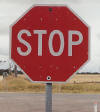 |
STOP. Probably the most important and widely
recognised road sign world wide.
You are required to come to a complete stop and proceed only after it is
safe to do so.
Stratford, Vic. |
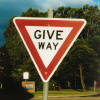 |
GIVE WAY. The standard Give Way sign used where
approaching traffic can be seen clearly before the intersection is reached.
Similar meaning to the US Yield sign.
Slow down and stop if necessary. Proceed into the intersection only when it
is safe to do so.
Stratford, Vic. |
|
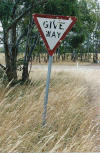 |
GIVE WAY. This is an example of an earlier style of
Give Way sign introduced in the late 1970's. Still very common. They are
slightly smaller in dimension and don't have the outer white border. Only a
red border.
Stratford, Vic. |
|
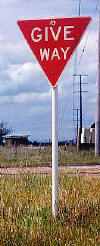 |
GIVE WAY. Remember these? Prior to the introduction
of the version above, Give Way signs were an all over red design with white
lettering and a thin white border.
This one has since been replaced. Other examples are known to exist, but few are on
public roads today.
Winnindoo, Vic. |
|
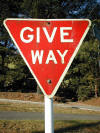 |
GIVE WAY. Another example of a red give way sign.
This one survived until quite recently at Cockatoo, Vic. |
|
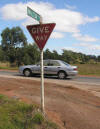 |
GIVE WAY. And yet another of these now rare
signs, still standing. Robin Hood. |
|
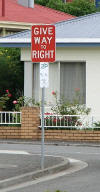 |
GIVE WAY TO RIGHT. These signs had a short
lifespan. I recall that they started to appear in the late 70s and
disappeared not long after. Mostly replaced by roundabouts. This
example survives in Hobart, Tas.
Thanks to David Morley for taking the photo. |
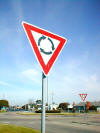 |
Roundabout. Same shape as the Give Way
sign. You are required to give way to traffic already on the roundabout.
Many people mistakenly believe the rule is "Give way to the right". As
traffic can only travel clockwise, it is effectively the same thing. But
is a problem when you encounter those drivers who enter a roundabout at
too high a speed. Stratford, Vic. |
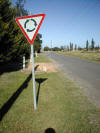 |
Roundabout. Here's an example
of an earlier style of Roundabout sign. Much the same, but without the
white border. Yarragon, Vic. |
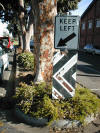 |
KEEP LEFT. Generally found on the median strips of
divided roads to direct traffic to the correct (left) carriageway. It is
illegal to drive to the right of such a sign. Although as you'll see on this
site later, this does not apply when the sign in incorrectly placed.
Maffra, Vic. |
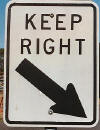 |
KEEP RIGHT. Very rare in Australia, but Keep Right
signs do exist. They are used in exceptional circumstances where traffic
must keep to the right of the sign. Examples I know of are special bus stop
lanes separated by a traffic island and in Melbourne where trams run to the
left of the road rather than the centre.
Unfortunately, I have seen more examples of the misuse of these signs
than correct use. See some examples on the Errors
and Oddities pages.
Tatura, Vic. |
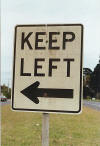 |
KEEP LEFT. Earlier style. This type of Keep Left
sign was in use in the 1960's and 70's. Many are still in use however. This
one near Traralgon, Vic. has since been replaced. |
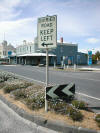 |
DIVIDED ROAD KEEP LEFT. Quite rare today, these signs
were used in the 1960's when divided roads were not so common as they are
today.
This example was in Yarram until some time in 2003 when it
was replaced by a 50 speed limit sign. |
 |
SLOW VEHICLES USE LEFT LANE. This sign isn't seen
as often as it was before the introduction of Keep Left Unless
Overtaking signs. It is still a standard sign for use where an extra
lane is added on climbs however. Rosedale, Vic. |
 |
LOAD LIMIT ON BRIDGE 20t. Not long after this
photo was taken, the 20t was altered to read 2t. The bridge
has since been replaced. Bushy Park, Vic. |
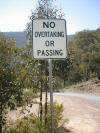 |
NO OVERTAKING OR PASSING. Used on narrow sections
of road. More often than not, this will be a narrow bridge, as was the
case here. Alpine National Park, north of Licola, Vic. |
 |
SAFETY ZONE - KEEP LEFT.
Used around Melbourne as a refuge for people waiting
for or getting off trams. Note the hole in the Keep Left arrow. This
allows people to see approaching trams without stepping onto the
tramlines. Melbourne, Vic. |
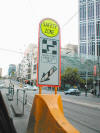 |
SAFETY ZONE plus RIGHT TURN FROM LEFT ONLY.
Safety Zone is a refuge area on the road, usually for tram passengers.
It enables passengers to get on and off trams safely and traffic to pass
without hitting them. Where there is no safety zone it is an offence to
pass a stationary tram. Right Turn from Left (or Hook Turn) is an
unusual turn which keeps right turning traffic from blocking the tram
lines. You signal for a right turn, but stay in the left lane and pull
over as far left as practical and await the traffic lights in the street
you intend to turn into, to turn green.
Melbourne, Vic. (and nowhere else). |
